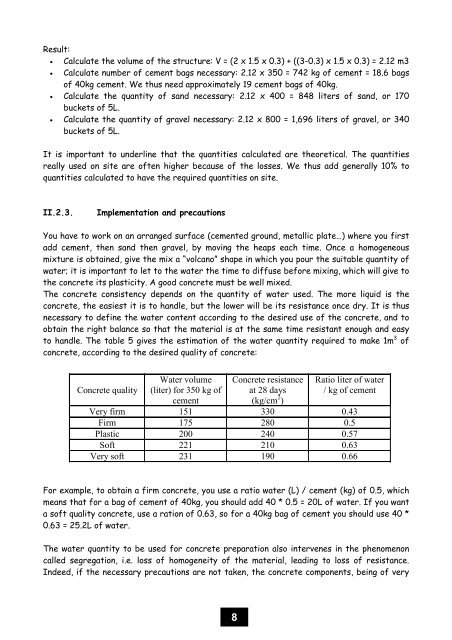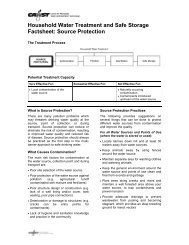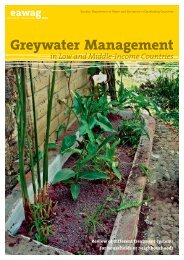Module 4 - Construction of a gravity fed system
Module 4 - Construction of a gravity fed system
Module 4 - Construction of a gravity fed system
You also want an ePaper? Increase the reach of your titles
YUMPU automatically turns print PDFs into web optimized ePapers that Google loves.
Result:<br />
• Calculate the volume <strong>of</strong> the structure: V = (2 x 1.5 x 0.3) + ((3-0.3) x 1.5 x 0.3) = 2.12 m3<br />
• Calculate number <strong>of</strong> cement bags necessary: 2.12 x 350 = 742 kg <strong>of</strong> cement = 18.6 bags<br />
<strong>of</strong> 40kg cement. We thus need approximately 19 cement bags <strong>of</strong> 40kg.<br />
• Calculate the quantity <strong>of</strong> sand necessary: 2.12 x 400 = 848 liters <strong>of</strong> sand, or 170<br />
buckets <strong>of</strong> 5L.<br />
• Calculate the quantity <strong>of</strong> gravel necessary: 2.12 x 800 = 1,696 liters <strong>of</strong> gravel, or 340<br />
buckets <strong>of</strong> 5L.<br />
It is important to underline that the quantities calculated are theoretical. The quantities<br />
really used on site are <strong>of</strong>ten higher because <strong>of</strong> the losses. We thus add generally 10% to<br />
quantities calculated to have the required quantities on site.<br />
II.2.3.<br />
Implementation and precautions<br />
You have to work on an arranged surface (cemented ground, metallic plate…) where you first<br />
add cement, then sand then gravel, by moving the heaps each time. Once a homogeneous<br />
mixture is obtained, give the mix a “volcano” shape in which you pour the suitable quantity <strong>of</strong><br />
water; it is important to let to the water the time to diffuse before mixing, which will give to<br />
the concrete its plasticity. A good concrete must be well mixed.<br />
The concrete consistency depends on the quantity <strong>of</strong> water used. The more liquid is the<br />
concrete, the easiest it is to handle, but the lower will be its resistance once dry. It is thus<br />
necessary to define the water content according to the desired use <strong>of</strong> the concrete, and to<br />
obtain the right balance so that the material is at the same time resistant enough and easy<br />
to handle. The table 5 gives the estimation <strong>of</strong> the water quantity required to make 1m 3 <strong>of</strong><br />
concrete, according to the desired quality <strong>of</strong> concrete:<br />
Concrete quality<br />
Water volume<br />
(liter) for 350 kg <strong>of</strong><br />
cement<br />
Concrete resistance<br />
at 28 days<br />
(kg/cm 2 )<br />
Ratio liter <strong>of</strong> water<br />
/ kg <strong>of</strong> cement<br />
Very firm 151 330 0.43<br />
Firm 175 280 0.5<br />
Plastic 200 240 0.57<br />
S<strong>of</strong>t 221 210 0.63<br />
Very s<strong>of</strong>t 231 190 0.66<br />
For example, to obtain a firm concrete, you use a ratio water (L) / cement (kg) <strong>of</strong> 0.5, which<br />
means that for a bag <strong>of</strong> cement <strong>of</strong> 40kg, you should add 40 * 0.5 = 20L <strong>of</strong> water. If you want<br />
a s<strong>of</strong>t quality concrete, use a ration <strong>of</strong> 0.63, so for a 40kg bag <strong>of</strong> cement you should use 40 *<br />
0.63 = 25.2L <strong>of</strong> water.<br />
The water quantity to be used for concrete preparation also intervenes in the phenomenon<br />
called segregation, i.e. loss <strong>of</strong> homogeneity <strong>of</strong> the material, leading to loss <strong>of</strong> resistance.<br />
Indeed, if the necessary precautions are not taken, the concrete components, being <strong>of</strong> very<br />
8

















